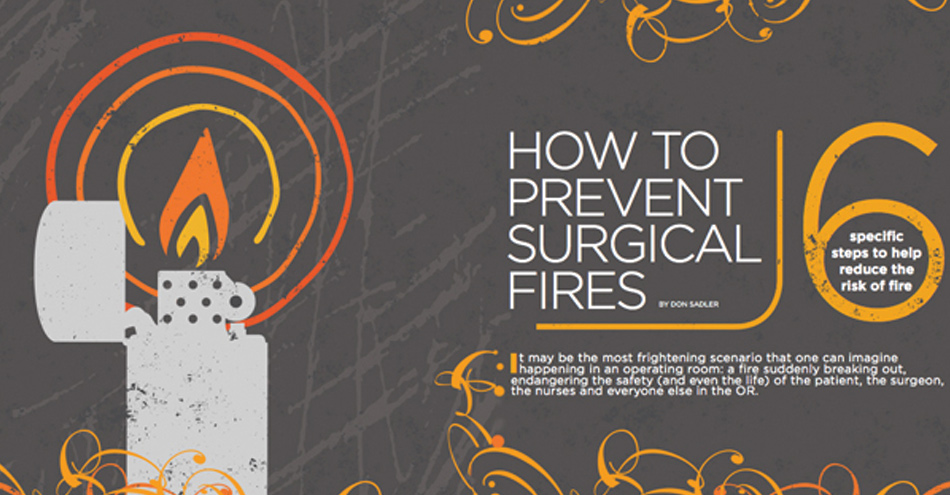How to Prevent Surgical Fires
by Don Sadler

It may be the most frightening scenario that one can imagine happening in an operating room: a fire suddenly breaking out, endangering the safety (and even the life) of the patient, the surgeon, the nurses and everyone else in the OR.
While extremely rare — it’s estimated by ECRI Institute that between 200 and 240 occur in the United States each year out of 65 million surgical cases — surgical fires can be devastating when they break out. Cathy Reuter Lake formed SurgicalFire.org after her 72-year-old mother was burned in a surgical fire in 2002. Her mother sustained second and third-degree burns to her head, neck and upper airway. She suffered through a treatment that included multiple infections and was sedated for seven weeks to ease the pain.
Surgical fires are fires that occur in, on or around a patient undergoing a medical or surgical procedure. They can cause second and third-degree burns to patients and, in a worst-case scenario, death when they occur in the patient’s airway. The ironic thing about surgical fires is that even though they are rare, they are completely preventable when OR personnel follow a few simple procedures.
The first step in the process is to understand how surgical fires occur. This is best illustrated by envisioning a three-sided “fire triangle” represented by an oxidizer, fuel and an ignition source.
“Surgical fires can only occur when all three side of the triangle are present, which is usually the case in the OR,” says Byron L. Burlingame, MS, RN, CNOR, a perioperative nursing specialist with the Association of periOperative Registered Nurses (AORN) and a member of the FDA fire prevention initiative task force. “This is why the OR environment is especially vulnerable to fires.”
It is vital that everyone in the operating room remains aware.
“Everyone who is present in the OR needs to understand their role and relation to each side of the fire triangle,” adds Melissa K. Fischer RN, MSN, CNOR, Clinical Specialist, Marketing Manager, for Megadyne Medical Products, Inc. “If you control each side of the fire triangle, you will prevent surgical fires from occurring.”
The OR is often an oxygen-rich environment with a higher concentration of oxygen than in ordinary room air because of the delivery of supplemental oxygen to patients. Electrosurgical units (ESUs), lasers and fiber optic light sources can serve as ignition sources. Surgical drapes, alcohol-based skin prep agents, and the patients themselves can serve as fuel sources.
“The oxygen-rich environment in the OR is a key cause of surgical fires starting and quickly getting out of hand,” says Fischer.
Burlingame says that 75 percent of all surgical fires occur in an oxygen-rich environment and 70 percent are ignited by an electrosurgical active electrode.
It is vital to keep the three ingredients that make up the fire triangle separate.
“The key to preventing surgical fires is keeping the three sides of the fire triangle from coming together,” he says. “For example, when using an alcohol-based skin prep antiseptic, OR nurses should make sure the skin is dry before draping the patient and allowing the surgery to begin.”
The OR personnel should evaluate whether supplemental oxygen is absolutely necessary for the patient — especially if the surgery is occurring in the head, neck or upper chest area. In these cases, a closed oxygen delivery system should be used whenever possible, “Any increase in oxygen concentration in the surgical field increases the chance of a fire,” adds Burlingame, who recommends that when used, supplemental oxygen should not exceed 30 percent. “The minimum concentration of oxygen needed to maintain adequate oxygen saturation should be delivered to the patient.”
During his more than three decades in the OR, Peter Rossi, BS, RN, Nurse Manager Surgical Operations at Halifax Regional in Roanoke Rapids, N.C., says that he has experienced two surgical fires.
“The first one was caused by the use of a CO2 laser by a GYN surgeon, who began using the laser hand piece before the scrub nurse could get his target area surrounded by wet surgical towels,” Rossi says. “Poor communication between the laser operator and the scrub nurse allowed a reckless surgeon the opportunity to ignite the paper drapes in an oxygen-rich environment. The patient suffered second-degree burns on her perineum.”
How to reduce surgical fire risk
The Food and Drug Administration has launched an initiative called Preventing Surgical Fires to increase awareness of the risk of these fires and encourage surgical personnel to work together to adopt practices that will prevent them from occurring. As part of the initiative, the FDA has issued six specific recommendations to help reduce surgical fire risk:
 1. Conduct a fire risk assessment. This should be done before any surgical procedure begins, and the results shared by the circulating nurse with the entire perioperative team. “The team can then work together to carry out interventions that are appropriate to the risk level of the procedure,” says Burlingame.
1. Conduct a fire risk assessment. This should be done before any surgical procedure begins, and the results shared by the circulating nurse with the entire perioperative team. “The team can then work together to carry out interventions that are appropriate to the risk level of the procedure,” says Burlingame.
2. Use supplemental oxygen safely. As noted above, increases in oxygen concentration in the OR significantly increase the chances of a surgical fire. And fires burn hotter and faster in an oxygen-rich environment. If it’s determined that supplemental oxygen is necessary, surgical fire prevention steps should be taken, such as using a closed oxygen delivery system (like an endotracheal tube or laryngeal mask) and delivering the minimum oxygen concentration needed for the patient and the particular surgical procedure.
3. Use alcohol-based skin prep agents safely. Flammable antiseptics should not be allowed to pool during skin prep, and alcohol-soaked materials should be removed from the prep area. Adequate drying time should be allowed for the antiseptic (as prescribed in the labeling) and drying time should be extended when the antiseptic is used in skin folds or on hairy areas of the patient.
4. Use surgical devices and equipment safely. These include ESU’s, electrocautery devices, lasers and laproscopic electrodes, all of which can ignite a surgical fire.“These should always be shielded from the patient and placed in a holster, not on drapes or on the patient, when not in use,” says Fischer. Alternatives to these devices should be considered whenever surgery is being performed in the head, neck or upper chest area and high concentrations of supplemental oxygen are being delivered.
5. Communicate with surgical team members effectively. Everyone in the OR during the surgical procedure — the anesthesia professional, surgeon, clinician applying the skin prep agent, and perioperative nurses — must communicate openly and honestly before, during and after the procedure.
6. Plan how to manage a surgical fire. Finally, there needs to be a plan for how the OR team will respond in the worst-case scenario in which a surgical fire actually breaks out. How will the fire be extinguished? How will the OR be evacuated? Conduct fire drills to train for such an event, and always keep a carbon dioxide (CO2) extinguisher and saline handy to extinguish any fire that might erupt. “And if there’s a surgical fire, don’t be afraid to yell ‘Fire!’ ” says Burlingame.
Fischer says that Megadyne offers free continuing education programs and courses on preventing surgical fires to all OR personnel. To learn more, contact Megadyne at 800-747-6110.
To learn more about the FDA’s Preventing Surgical Fires Initiative, visit www.fda.gov/preventingsurgicalfires.











